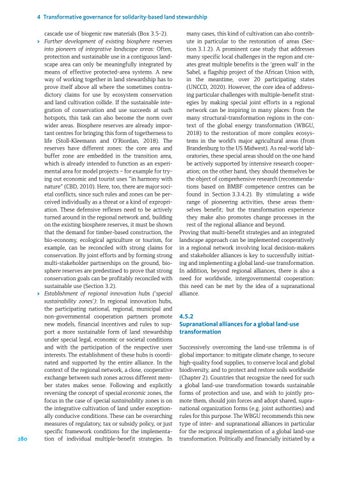4 Transformative governance for solidarity-based land stewardship
280
cascade use of biogenic raw materials (Box 3.5-2). > Further development of existing biosphere reserves into pioneers of integrative landscape areas: Often, protection and sustainable use in a contiguous landscape area can only be meaningfully integrated by means of effective protected-area systems. A new way of working together in land stewardship has to prove itself above all where the sometimes contradictory claims for use by ecosystem conservation and land cultivation collide. If the sustainable integration of conservation and use succeeds at such hotspots, this task can also become the norm over wider areas. Biosphere reserves are already important centres for bringing this form of togetherness to life (Stoll-Kleemann and O’Riordan, 2018). The reserves have different zones: the core area and buffer zone are embedded in the transition area, which is already intended to function as an experimental area for model projects – for example for trying out economic and tourist uses ”in harmony with nature” (CBD, 2010). Here, too, there are major societal conflicts, since such rules and zones can be perceived individually as a threat or a kind of expropriation. These defensive reflexes need to be actively turned around in the regional network and, building on the existing biosphere reserves, it must be shown that the demand for timber-based construction, the bio-economy, ecological agriculture or tourism, for example, can be reconciled with strong claims for conservation. By joint efforts and by forming strong multi-stakeholder partnerships on the ground, biosphere reserves are predestined to prove that strong conservation goals can be profitably reconciled with sustainable use (Section 3.2). > Establishment of regional innovation hubs (‘special sustainability zones’): In regional innovation hubs, the participating national, regional, municipal and non-governmental cooperation partners promote new models, financial incentives and rules to support a more sustainable form of land stewardship under special legal, economic or societal conditions and with the participation of the respective user interests. The establishment of these hubs is coordinated and supported by the entire alliance. In the context of the regional network, a close, cooperative exchange between such zones across different member states makes sense. Following and explicitly reversing the concept of special economic zones, the focus in the case of special sustainability zones is on the integrative cultivation of land under exceptionally conducive conditions. These can be overarching measures of regulatory, tax or subsidy policy, or just specific framework conditions for the implementation of individual multiple-benefit strategies. In
many cases, this kind of cultivation can also contribute in particular to the restoration of areas (Section 3.1.2). A prominent case study that addresses many specific local challenges in the region and creates great multiple benefits is the ‘green wall’ in the Sahel, a flagship project of the African Union with, in the meantime, over 20 participating states (UNCCD, 2020). However, the core idea of addressing particular challenges with multiple-benefit strategies by making special joint efforts in a regional network can be inspiring in many places: from the many structural-transformation regions in the context of the global energy transformation (WBGU, 2018) to the restoration of more complex ecosystems in the world’s major agricultural areas (from Brandenburg to the US Midwest). As real-world laboratories, these special areas should on the one hand be actively supported by intensive research cooperation; on the other hand, they should themselves be the object of comprehensive research (recommendations based on BMBF competence centres can be found in Section 3.3.4.2). By stimulating a wide range of pioneering activities, these areas themselves benefit; but the transformation experience they make also promotes change processes in the rest of the regional alliance and beyond. Proving that multi-benefit strategies and an integrated landscape approach can be implemented cooperatively in a regional network involving local decision-makers and stakeholder alliances is key to successfully initiating and implementing a global land-use transformation. In addition, beyond regional alliances, there is also a need for worldwide, intergovernmental cooperation: this need can be met by the idea of a supranational alliance.
4.5.2 Supranational alliances for a global land-use transformation Successively overcoming the land-use trilemma is of global importance: to mitigate climate change, to secure high-quality food supplies, to conserve local and global biodiversity, and to protect and restore soils worldwide (Chapter 2). Countries that recognize the need for such a global land-use transformation towards sustainable forms of protection and use, and wish to jointly promote them, should join forces and adopt shared, supranational organization forms (e.g. joint authorities) and rules for this purpose. The WBGU recommends this new type of inter- and supranational alliances in particular for the reciprocal implementation of a global land-use transformation. Politically and financially initiated by a
